Just a pattern post for another option to the well-loved Dublin Dragons pattern. This one uses 4 threads per card rather than just 2, and is a great beginner’s pattern using only 12 picks and is twist-neutral.
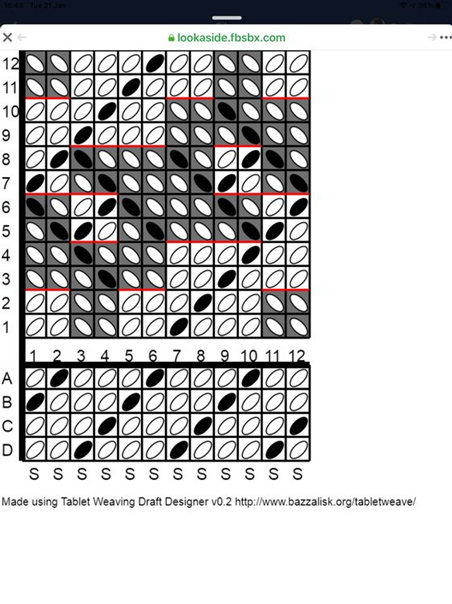
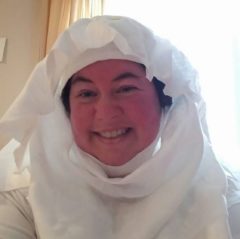
Lady Elewys of Finchingefeld, JdL, GdS
My creative SCA journey on stuff I make and research I do…mostly in fibers (wool prep, spinning, weaving, tablet weaving) and glass beads, but could also include costumes, camping, cooking, and any other creative things that strike my fancy.
Just a pattern post for another option to the well-loved Dublin Dragons pattern. This one uses 4 threads per card rather than just 2, and is a great beginner’s pattern using only 12 picks and is twist-neutral.

In the last year, I have done more research on tablet weaving patterns–finding new ones to explore, create, and share, as well as trying to use more period materials of the correct size to recreate tablet woven bands more in line with the extant finds. I have begun using technology during this age of plague to share my weaving skills with others, teaching across the miles and over seas. I have also started re-exploring interests in fiber processing and spinning as well as woodworking, and of course, spending some time enhancing my wardrobe.
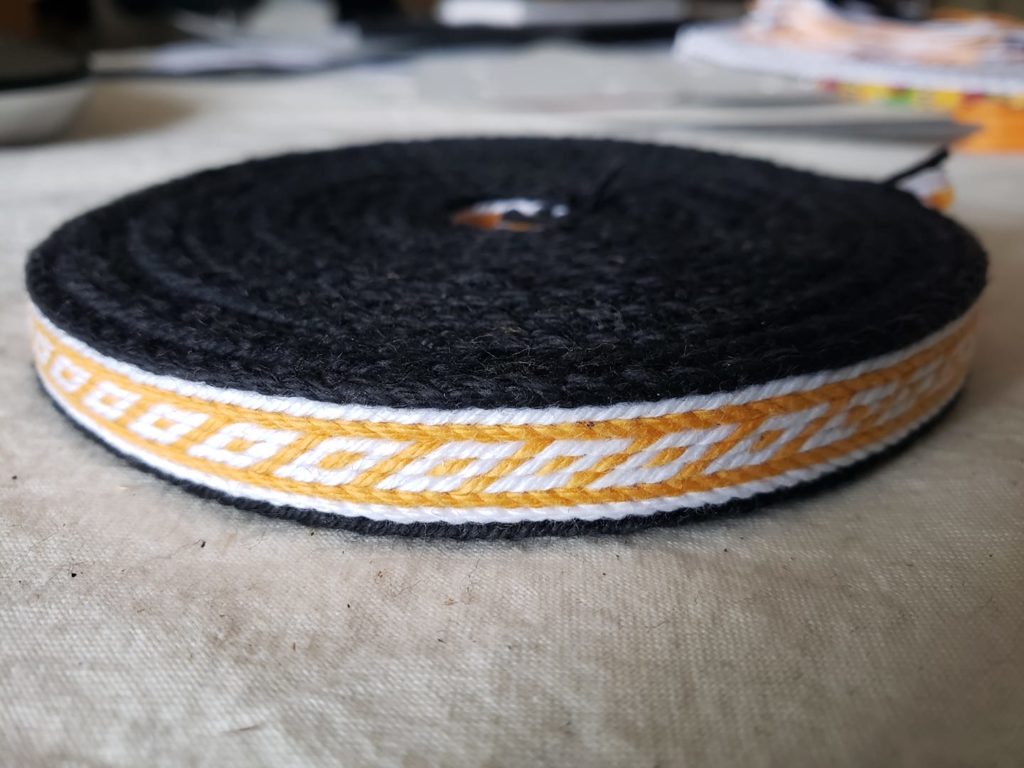
Tablet weaving, like other arts, is not something that is easy to learn from a book, and some people simply learn a technique better by watching rather than reading and experimenting. Over the years, I had been looking for videos about tablet weaving to learn a technique or a pattern, and so many of them are missing one or more elements to the instruction, and fail to walk the viewer through the process, step by step. There was one very long instructional (nearly three hours) where the viewer is sitting in on a class, but the video quality is rather poor, the room is dark, and there are virtually no close ups to doing each step.
Most of the other videos already had the loom warped, which is a significant gap in the learning of the craft, and leaves weavers wondering about threading the cards, the difference between S and Z threading (which can be different in various parts of the world), the history of the pattern (which may not be the purpose, but for SCA tablet weavers, this is of interest)–and one of the biggest issues–how to read the patterns.
To make things even more complicated, there are several different ways that weavers draw up patterns, and knowing how to determine which ways the cards face, how to thread correctly and how to turn the cards in sequence between one system and the next is a HUGE learning curve and can be profoundly discouraging to new weavers. Even experienced weavers may think, “I got this,” then find that their pattern is appearing on the underside of the band and they’ve got gobbledygook on the top.
In order to fill that void, I decided to make a YouTube video series on how to do tablet weaving from start to finish. I made a list of things that students need to learn the craft in video form–which would be true for any art:
Start simple. Use a pattern/project that anyone could do.
Use easily accessible tools and materials. Keep investment costs low.
Explain each step clearly and demonstrate the techniques.
Do close ups, and work slowly. Repeat complex processes.
Have good lighting and sound, and use a tripod if you don’t have an assistant.
For history nerds, add some background information to the piece.
Make it entertaining and not too long.
Smile and have fun!
Also important, make sure you’re in a quiet, organized space…I’ve been contending with loud neighbors with pressure washers & lawn mowers …and “roommates”…
With those points in mind, I set out to make tablet weaving more accessible to the beginning weaver who may not have a teacher nearby (or may not be able to get to classes during this pandemic) and showing others how easy it is to create beautiful, period tablet woven pieces, even as a beginner. I discuss yarns to use, threading the cards, tying a secure knot, reading the pattern, turning cards, advancing the warp, and most importantly, the satisfying snip as you remove your finished project off the loom.
It was my dearest friend, HL Aenor de Pessac, who initially suggested it, although I was thinking about doing something very similar, just not sure how to execute it myself. In discussion with her, we developed the idea further and came up with a plan. She not only encouraged me to make the videos, but has been instrumental with editing and movie magic, which I had no idea how to do (I’m learning!). I owe her a great deal of credit and thanks.
The first video is a very easy pattern and each subsequent video builds on the skills learned, and my emphasis is using period patterns or designs. As a fun side project, each new piece will be done in the colors of the 20 SCA Laurel Kingdoms, in chronological order of creation, starting with the West Kingdom. There are also a couple short videos with quick weaving tips and tutorials on adding new weft thread and weaving a pattern in reverse to untwist the warp. More tutorials will be added in the future as they occur to me or if I get requests from viewers. In the first month, I added 50 subscribers to my YouTube channel after releasing just one full video, and 50 more more since then. Feedback I’ve gotten so far is that this is something people had been looking for, and I’m delighted!
In addition, and as a supplement to the videos, I have made use of my blog to post the patterns and add additional details and instructions for students. Links are provided in the videos for the patterns and the products I use if anyone is interested in finding them.

Two of the videos focused on one piece in particular: Oseberg 12L1, one of at least 10 tablet woven bands found in a large burial mound that was discovered at the Oseberg farm near Tønsberg in Vestfold county, Norway in 1904. The Oseberg dig, as it is known today, had finds which date to around 834 AD. The burial mound contained two female skeletons–the ages of which are estimated to be about 80 years old and 50-55 years. The ship and some of its contents are displayed at the Viking Ship Museum at Bygdøy, Oslo, others are located at the nearby Historical Museum. Among its finds were a loom (commonly called the Oseberg loom), weaving tablets, several narrow bands, a wooden cart, woolen textiles, imported silks, and narrow tapestries. Earlier grave robbers took valuables, but in my opinion, they left the good stuff behind!
To recreate the tablet woven trim known as Oseberg 12L1. The original was made of silk (or silk & linen) and measured only 5 mm wide, and I have done several experiments to get the correct size of the woven piece using various silk and cotton threads that I can acquire from commercially made goods.

The piece itself has few images available, and the museum keeps it in a dark room to prevent further decay and no photographs are allowed.
Original was reportedly in silk (or silk and linen). Some may be surprised that silk was used so much in tablet weaving in Scandinavia, but there was a great deal of Central Asian and Middle Eastern imports into the area, particularly to Birka, a renowned trading center about 540 km away, which was in the midst of its heyday. Birka operated as a trading town from 750 to 960 AD, bringing in goods from the far northern realms of the Saami down to the Byzantine Empire and beyond. The Byzantines had been silk farming for a couple hundred years before Birka opened for business.

Imported silks may have been dyed prior to arriving in Scandinavia, but if they had been adding color after, a huge variety of colors were available. Madder for red, woad for blue, weld and broom for yellow, and more colors achievable from heather, birch leaves, buckthorn, bedstraw, walnut, and lichens. There were clearly other imported dye stuffs as there is evidence of items being dyed with kermes and cochineal, which come from more southern regions.
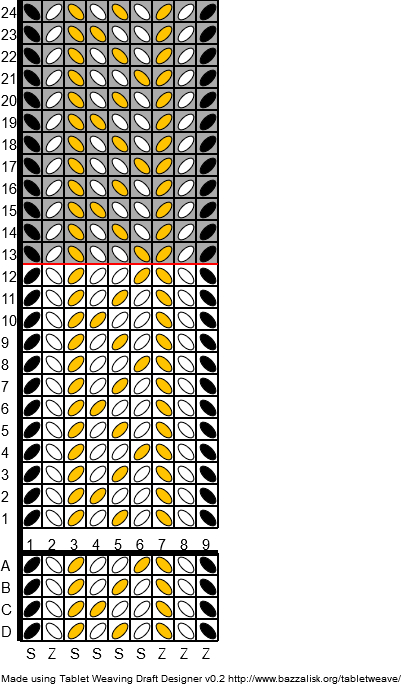
After a couple of experiments, and chatting with other weavers around the world, the pattern that is most likely to be accurate is this one–give or take a couple of additional border cards. More on that later.
This pattern, actually, has an additional border card on one side to create a more balanced design; it appears that the one in period had 8 cards instead of 9, but to create this piece in An Tir colors, I decided to add another black stripe on the other side. I like the symmetry. It appeals to my OCD nature.
Warped onto my inkle loom; although not period, it is my preferred method of weaving as it is portable, maintains even tension, and sitting at a standard table, it provides ergonomic comfort…it also works in harmony with my life as a busy mom. I began weaving inkle some 25 years ago and invested in this loom (spent a whole $20 at an event for this) and it has been an invaluable tool!
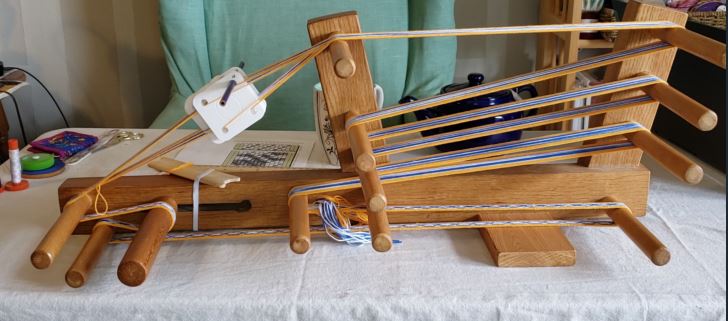
Backstrap looms are a favorite among many weavers around the world. This was something I tried once or twice, but found that it restricted mobility as you’re tethered to a stationary object.

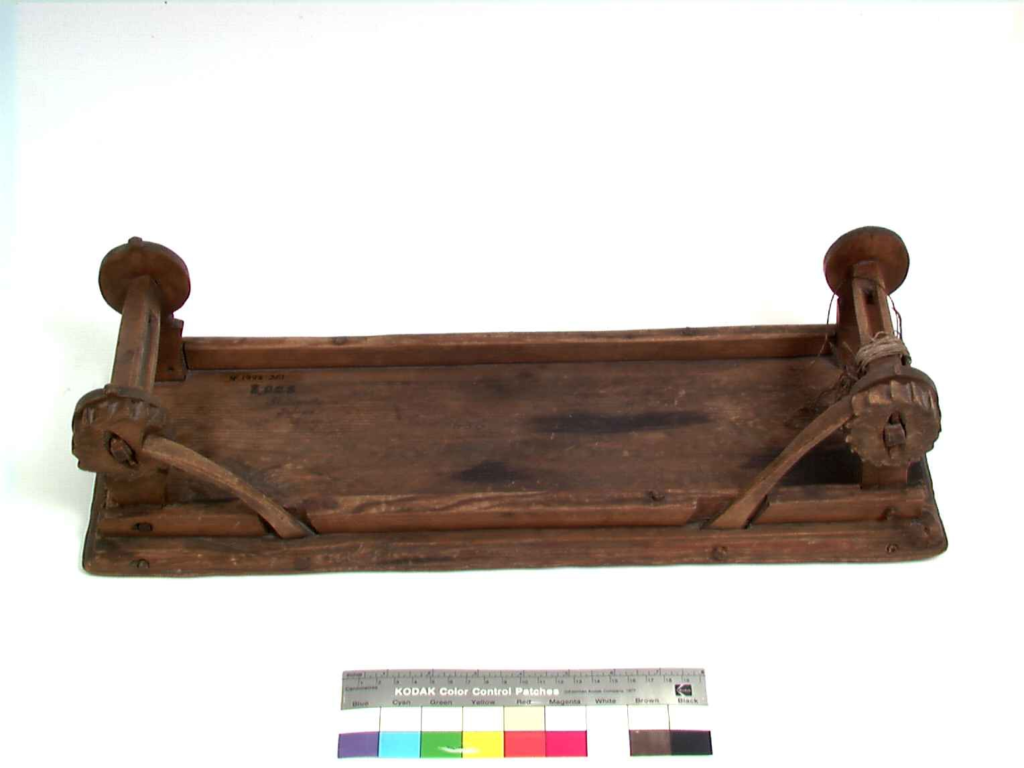
Box (or tape) looms are portable and very event-friendly, but can have tension issues, as the weaver has to be able to warp the loom with some expertise. It also requires the use of a warping board or a similar technique to measure all the lengths of warp at once before loading it onto the loom. These appear later in the Middle Ages, around the 1400s, so not quite Norse period appropriate.
Oseberg looms would be ideal for this project, as it was found at the same dig as the woven piece. They can be designed to come apart for easy transport and look fantastic while working on them at events. It can, however, be uncomfortable to work at for long periods as it requires the weaver to sit next to the work and twist the torso.

This is a modern portable design of tabletop Oseberg loom which can work if clamped to the table, but that also requires some skill at managing tension. Like the box loom, you must also have a warping board to measure out all your warps before loading and threading the cards. I find this one is a little long for easy use, but I may try to make a shorter version.

I recall someone suggesting using a warp weighted loom to do tablet weaving, but that doesn’t seem practical. Warp weighted looms require space to set up and a wall for the loom to lean against, and the weaver stands at the loom to work. It seems like a whole lot of loom for such a small project. It’s definitely not portable. I have seen theories on how tablet weaving may have been done as edge finish on a project and worked at the same time as the rest of the fabric was woven (I haven’t done any serious research on this yet). There are ways that one could do warp-weighted weaving with tablets on a small scale, but nothing that I could find in period that demonstrates this technique.

My preferred cards are 3 1/4″ Schacht tablet weaving cards as they have color coding on the edges. This is ideal for checking the position of the cards at a glance, which is much more helpful in complex patterns, where cards are turning forwards and backwards in the same pick and should return to the ‘home’ position at the end of a sequence; if you make a mistake and they are not turned correctly, you can see this immediately. I find it to be a great visual cue. They are a bit bigger than period cards, however–those found in the Oseberg dig were about 2 1/2″ wide.
In period, bone, wood, antler, leather, and other materials were used to make cards. I have a few now that are made from wood, and they work well for some projects although I find that they don’t turn as smoothly as other materials. Perhaps over time they will become smoother with use. I have probably 300 cardboard ones that have fallen into my possession over the years, so I do not lack for supply at this point.

Textiles found on the Oseberg Viking ships shown with tablet-weaving cards. Bygdøy, Oslo, Norway.Textiles found on the Oseberg Viking ships in 1904 shown with tablet-weaving cards. Bygdøy, Oslo, Norway. Oseberg 34D tablet woven band pictured here (not the piece I’m recreating). Based on this image, I estimate these wooden cards are about 2 1/2″ across.
I made multiple pieces for this Oseberg 12L1 re-creation. The first using Maysville 8/4 Carpet Warp, which is 100% cotton. 8 cards were used in this pattern, and using this yarn yielded a width of 10 mm (1 cm) in the finished project. Given that the original measured 5 mm, I knew I needed to use something much finer.
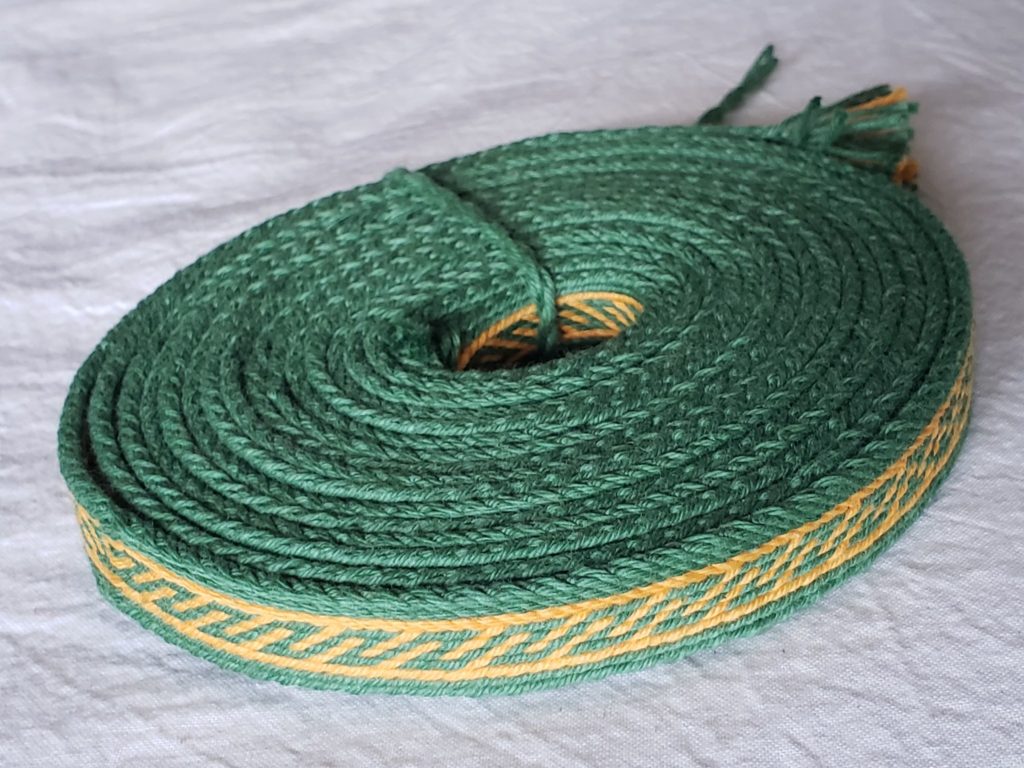
My second attempt at this pattern was using 60/2 silk that I had on hand (purchased a little more than a year ago from Eowyn the Weaver on Etsy). This is the same silk that I used in the French tablet weaving that I did last year from 7th century Merovingian Queen Bathilde, which resulted in a near-perfect match for finished size; the original was 18 mm and mine finished at 15 mm.
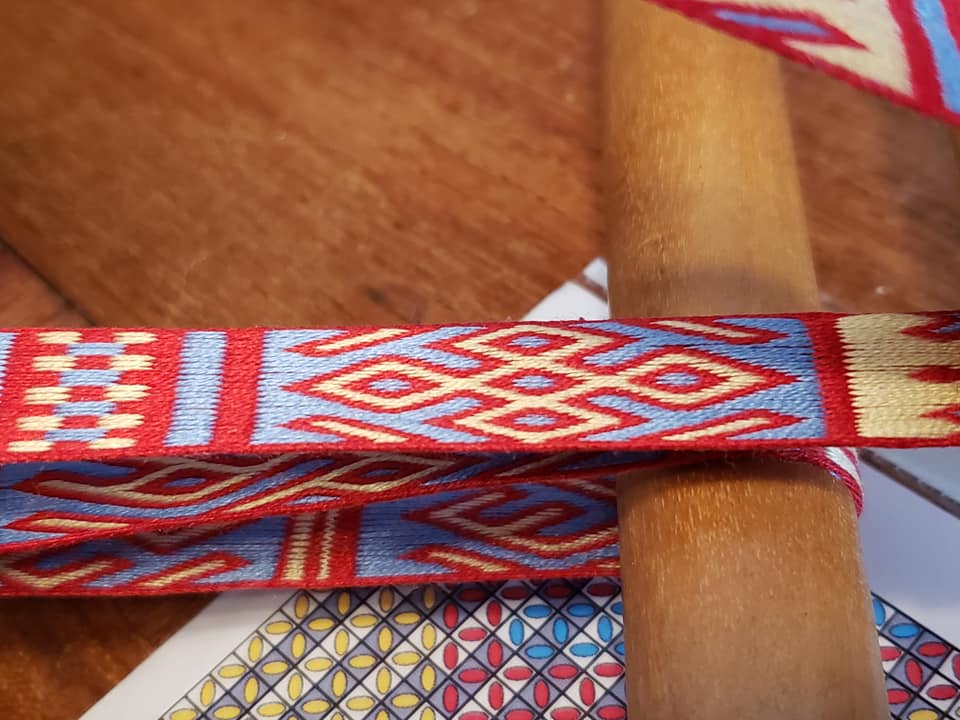
Wanting to create a slightly different esthetic to this piece with balanced borders using colors that mimic other Scandinavian narrow bands, I altered the pattern slightly, adding 3 extra cards to the borders, but the finished width was still only 4 mm; significantly smaller than the original.


I decided to warp up a very small project on the Oseberg table loom with size 10 crochet cotton. It’s what I have on hand and given the pandemic and limited ability to search for other options in the stores…we’ll go with it.
And wouldn’t you know it…it’s a match! 5 mm exactly! So if silk is not available, this is the size you can use for period tablet weaving.
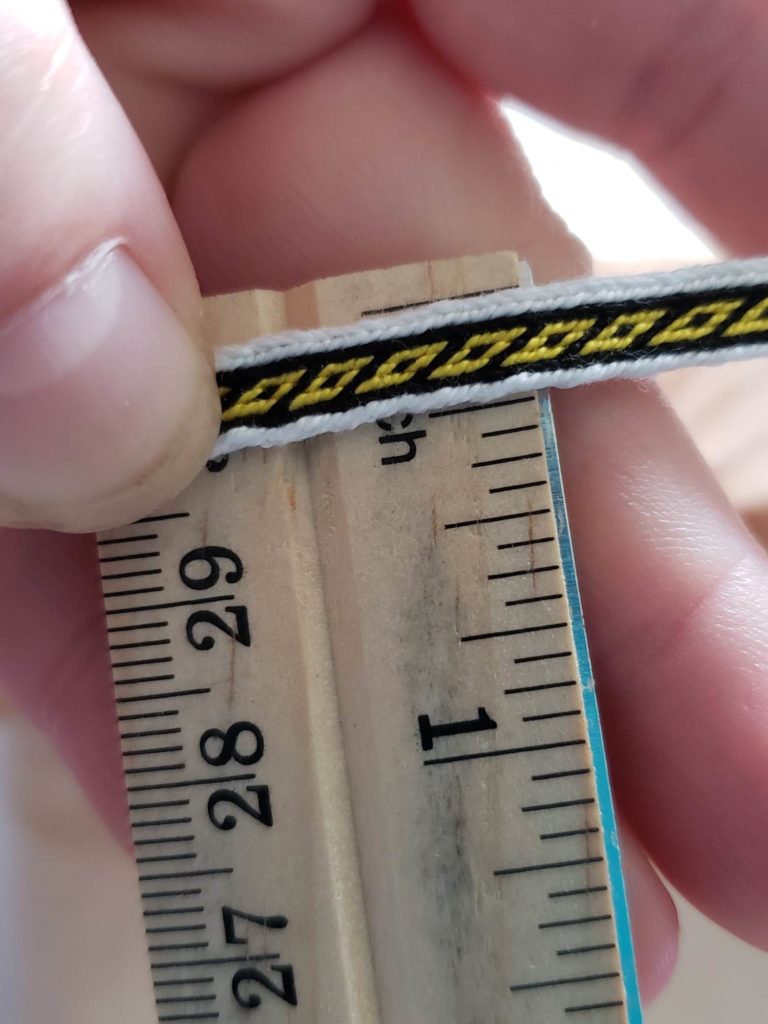
I ordered some 20/2 silk, which was listed as ‘lace weight’ yarn, hoping that the slightly larger size would yield better, and more size-appropriate, results. Discussions with one of my Oseberg connections suggests that this would be the proper size thread. I warped up the loom in the 20/2 silk to test the size and it’s exactly the right size!
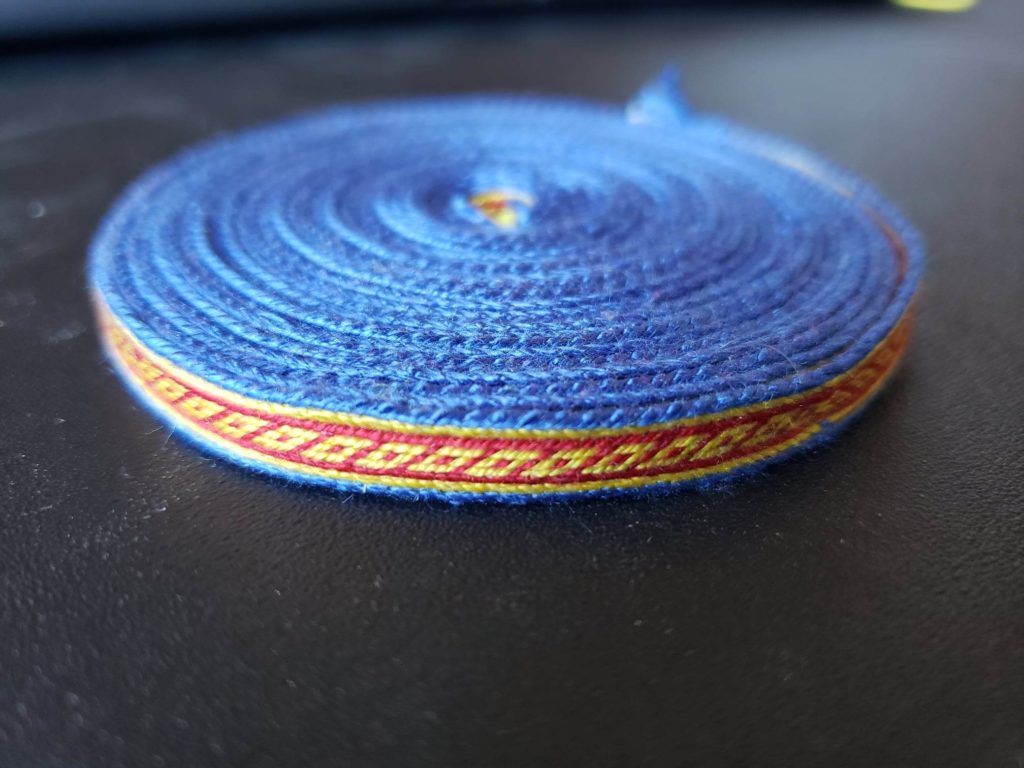
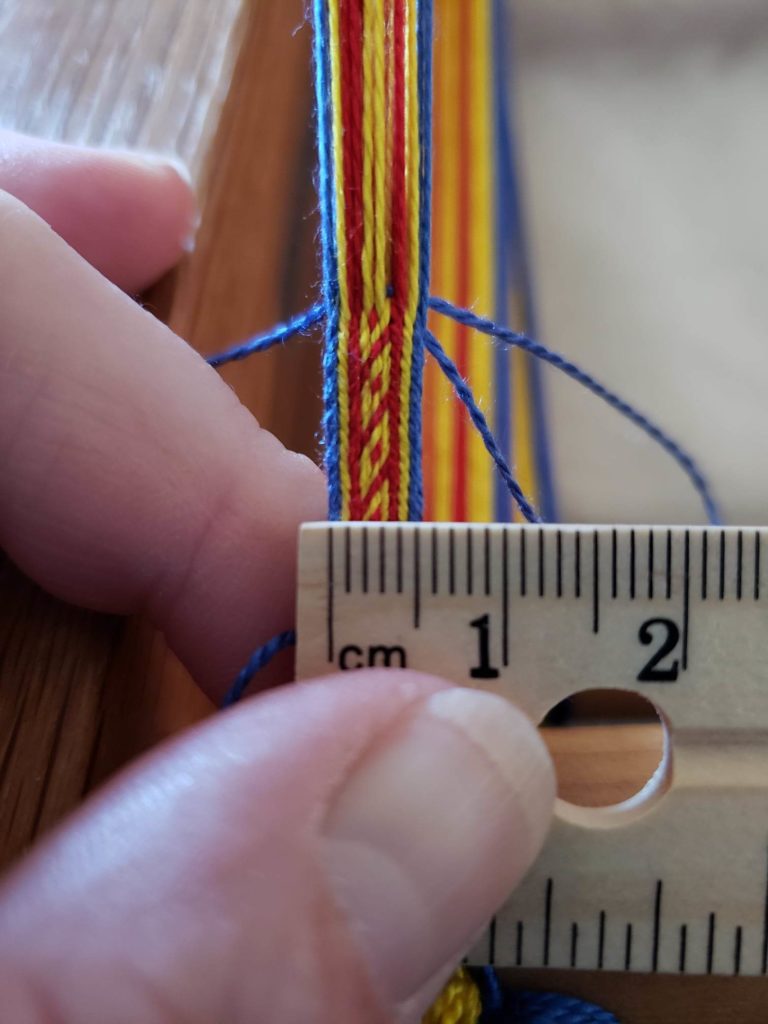

Brand new research–and I mean the book is due out next month–is that the band appears to have had a few additional threads added on the edges, possibly in linen or some other vegetable fiber, that has deteriorated over time. Bente Skogsaas, a weaver from Norway who has authored this book, noted in her study of the piece that the weft has small loops on the edges, as if there were more threads that had been there but had decayed. She suggests that it’s possible that they found it difficult to sew through the silk to attach the weaving onto garments, so the linen threads added to the edge was easier to sew through. I agree with this hypothesis and contend that sewing through the linen is more forgiving to that kind of abuse than the silk. I can imagine that silk might pucker or gape in an unattractive way if you sew through it. Also, if the silk needs to be removed for laundering the garment or attaching to a new garment, it would put the wear and tear on the linen instead of the silk.
Adding this linen border would increase the overall width of the woven piece; however, it would not change the look and dimensions of the main part of the design. Perhaps in the future, I’ll try weaving a piece using linen on the edges to see how this changes the width and if it makes a difference in attaching the woven piece to a garment.
There are many more period bands to research and recreate, and more videos to be made for new weavers. I still have 18 more woven bands to finish for the Laurel Kingdoms video series project, and the next one (a sneak peek for you all!) is going to be a throw back to ancient times, the Hallstatt 3 band (HallTex 152) for the Kingdom of Atenveldt, which dates to 800-400 BCE. Some fantastic research was done on this piece three years ago and revealed a lot of great information about this fragment. The original was made in wool and I’m tempted to invest in a couple cones of weaving wool, but I need to find a source of affordable lace weight yarn that is strong enough for weaving.

Also, one of the items I will be weaving for a future project will be a brocade pattern, a weaving style that I have only done a very small amount of…about 3″ worth.

There is a project I’ve picked out to do and it has the least amount of brocade possible that would still qualify it as a brocade.

The only part of this design that is a brocade is the white zig zag across the top. This will be a great way for me to dip my toe into the waters of brocade without being overwhelmed, like I was in my first project.
The Køstrup band is another one that I’m thinking about doing which has a series of different brocade designs and looks really stunning. This find was in a 10th century grave from Denmark.

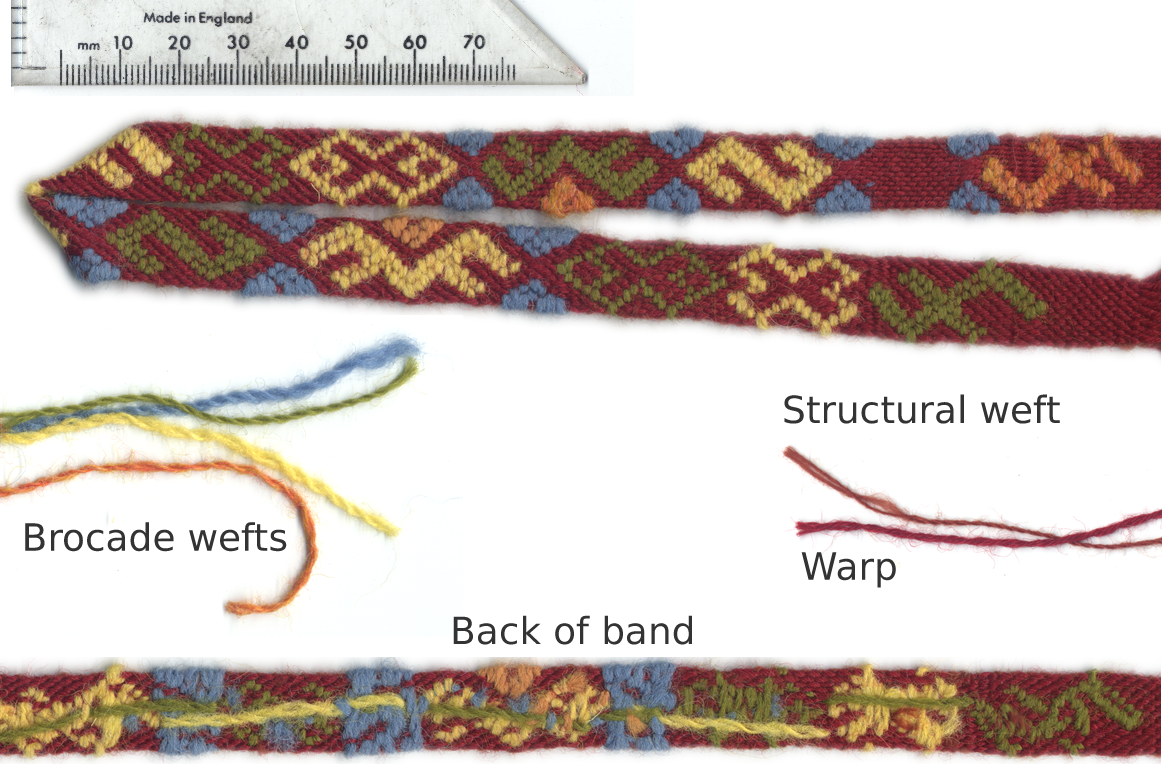
I’m looking forward to learning and teaching more using the online platforms, and–when this plague leaves us behind–teaching in person when possible.
Gundersen, Kristine. Viking Age Dyes: A Brief Overview. 2013 (Also Tournaments Illuminated #191, 2014). https://www.academia.edu/4652690/Viking_Age_Dyes-_A_Brief_Overview
Kjell S-e Bull-Sveen blog: https://vevstua.bull-sveen.net/?p=5556.
Lester-Makin, Alexandra. The Lost Art of the Anglo-Saxon World: The Sacred and Secular Power of Embroidery, 2019.
Lewins, Shelagh. https://www.shelaghlewins.com/tablet_weaving/gallery/kostrup_notes.htm
Norsk Folkemuseum. https://norskfolkemuseum.no/
Pasanen, Mervi. Applesies and Fox Noses. ISBN 978-952-5774-49-8, Salakirjat, 2013. https://www.salakirjat.com/product/159/applesies-and-fox-noses—finnish-tabletwoven-bands
Priest-Dorman, Carolyn. Colors, Dyestuffs, and Mordants of the Viking Age: An Introduction. https://www.cs.vassar.edu/~capriest/vikdyes.html
Skogsaas, Bente. Blog. http://www.findglocal.com/NO/T%C3%B8nsberg/733085720422001/Oseberg-tablet-weave
Skogsaas, Bente. Oseberg Tablet Weave Book I (34D) and Osebert Tablet Weave Book II (not yet published) https://www.facebook.com/bente.skogsaas/
Thunem, Hilde. http://urd.priv.no/viking/kostrup.html
Twisted Threads Kostrup pattern. https://twistedthreads.org/pattern/zn6qDBWB5QJ4mJJHw
University Museum of Norway Photo portal http://www.unimus.no/foto/#/search?q=Oseberg%20brikkevev*&museum=KHM
Viking Ship Museum https://www.khm.uio.no/english/visit-us/viking-ship-museum/exhibitions/oseberg/
Wikipedia. https://en.wikipedia.org/wiki/Oseberg_Ship#Burial_mound
Other Projects – Gallery
A gallery of images of other stuff I’ve been working on.
6th century tablet weaving for Birka Coat
Birka Coat
Six Board Box made in class from AMR
Inspiration photo for Pink Ladies Dress
The Pink Ladies Dress, 12th Night 2020
Oseberg 12L1
Oseberg variation
Ladoga Burial Mound, Karelia, Russia, 10-12th c.
Ladoga Burial Mound, Karelia, Russia, 10-12th c. skip hole variation
Birka 12, Sweden, 9th c.
Oseberg 12L1, silk
German 14th century
Checky fabric created from linen squares for Royal Sleeves, Sept Crown 2019
Checky linen, detail
Karelia, Russia 10-13th c.
Wool scouring, July 2020
Beading Royal sleeve for 12th Night 2020
Group applique on Royal Sleeve for 12th Night 2020
10 Replies to “Teaching Tablet Weaving During the Plague and Beyond”
‘Izza al-Dimashqiyaa ‘Izza al-Dimashqiyaa says:
July 14, 2020 at 3:19 pm Edit
You are my hero!
I took an class at an event and had so much fun I invested in a loom, cards, books, etc and then when I tried to sit down and do it at home…no luck. Every time I try to get started I can’t seem to get past the warping! Thank you so much for not just teaching, but truly starting at the beginning with warping, patterns, etc. I have now subscribed to your channel and will work on dusting off my cards and giving it another try. Thank you!!
Reply
Eowyn de Wever says:
July 14, 2020 at 12:41 pm Edit
The one comment on the warp weighted loom; I’ve seen two variants. One is a long board on a table, and the weights dangle off the end. (See Guntram, for instance.) The other is very similar to a setup for a viking tent, only with a much smaller top pole. On each side, you have two poles that meet at the top; mine has cord between the two poles around mid height so that the legs don’t spread apart too far.
The latter setup for me works nicely in front of the tv.
Reply
Elisabeth de Rossignol Elisabeth de Rossignol says:
July 13, 2020 at 8:53 pm Edit
I am currently checking out the YouTube videos. Congratulations and well done! You’re quite right that many instructional videos on YouTube don’t really address what the beginner needs to know, and recognizing this gap and addressing this is a real public service. I look forward to hearing more about your work and future plans.
Reply
Gwennan nic Ailpien says:
July 13, 2020 at 8:36 pm Edit
Greetings from the Hon Gwennan nic Ailpein in Shire of Lost Moor in Calontir!
I was very happy to see the advanced level of research and card weaving you have been doing. Cuz wow! Its wonderful to hear that you are teaching as well! I am glad to see that you also researched the different types of looms that were used with card weaving. Very nice!
Card weaving is not my specific specialty; I spin and weave, but on different types of looms as well as dyeing. I process the raw sheep wool into useable fiber and then spin and weave it.
I would love to chat with you in some way. I have a few questions for you concerning card weaving. I hope you will email me.
Have you done any dyeing or used handspun yarn for your projects?
I really enjoyed reading about and
seeing your wonderful work. Thank you for doing this!
Reply
Viscountess Kerij-e Viscountess Kerij-e says:
July 13, 2020 at 8:57 pm Edit
Hon Gwennan, you are welcome to sign up as a Participant and request a 1:1 meeting! ~ Kerji-e, Athenaeum Staff
Reply
Katelijne van der Ast Katelijne van der Ast says:
July 13, 2020 at 3:50 pm Edit
Hi Elewys,
Always a pleasure to see your work! I subscribed to your youtube channel as my daughter is interested in starting to tablet weave. Thank you so much for the wonderful examples and clear process steps.
Reply
Elonda Blue Haven says:
July 10, 2020 at 9:45 am Edit
Very interesting. I was just going to watch a portion of your video and ended up watching the whole thing. You have such a great teaching presence. I have a book on Latvian cardweaving that I picked up in Riga last September. I really would like to see your take on some of the items in there. It is written in Latvian but the pictures are in English.
Reply
Margaret Hamilton of Stirlingshire says:
July 9, 2020 at 7:07 pm Edit
Good angle on the video! That Oseberg pattern has quickly become a favourite, interesting to hear about the linen edge threads. Great article. Thank you!
Reply
Guido d’Aquila says:
July 9, 2020 at 6:48 pm Edit
I love the tablet weaving you have done. I’ve just started in the past two months and have jumped in with both feet. 50 bands so far. It would be great to chat some time.
Reply
Elewys of Finchingefeld Elewys of Finchingefeld says:
July 9, 2020 at 6:49 pm Edit
Sure! I would love to!
Reply
Exhibit Table of Contents
My Year in Review
Teaching at Home & Abroad
Enter “Weave Along With Elewys”
Building Skills
A Close Look at Oseberg 12L1, 834 AD
Goal
Extant Object
Materials
Colors
Pattern
Tools
Non-Period Loom Options
Period Loom Options
Backstrap
Box or Tape
Oseberg
Warp Weighted
Cards
Period Card Options
My Experiments in Weaving
8/4 Cotton Warp
60/2 Silk
20/2 Silk
Size 8 Crochet Cotton
Further Research
Future Weaving Projects
Hallstatt 3
Icelandic Brocade
Køstrup Brocade
Bibliography
Other Projects – Gallery
About the Exhibitor
Elewys of Finchingefeld Elewys of Finchingefeld
Branch: Barony of Aquaterra
Enthusiastic student, focusing on tablet weaving, lampworking, spinning & costuming. Serving Mistress Isolde as both apprentice & protégé for the last 5 years.
Athenaeum 2020
Sorry it took a couple days to get this posted. Ooops!
This is the third of the tablet weaving pieces (the most famous, anyway) that were found in an Austrian salt mine that date from 400-500 BC.
Here’s the pattern!
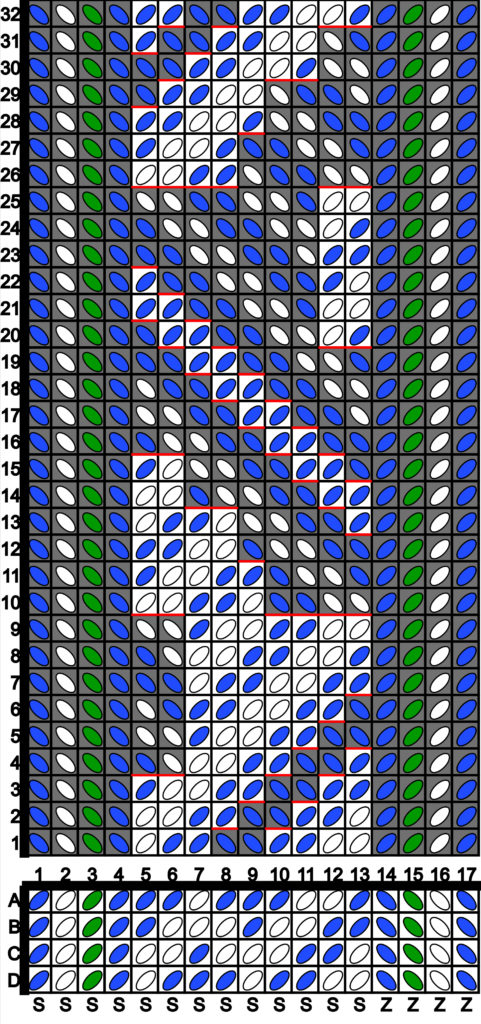
If you produce this, or any of the patterns that I have provided through my videos and on this forum, please post them to Instagram or Facebook (or your social media platforms that you use) and use #weavealongwithelewys or #elewysoffinchingefeld. You can find me on Instagram at Elewys_Finchingefeld.
Have a great day!
A landslide in 2020 uncovered a bunch of archaeological finds in a small village on the East coast of Iceland. Beads, a ring, and this fragment from a woman’s smokkr were found, and this piece of tablet weaving on the smokkr is a beautiful example of weaving from the 9th-11th centuries.

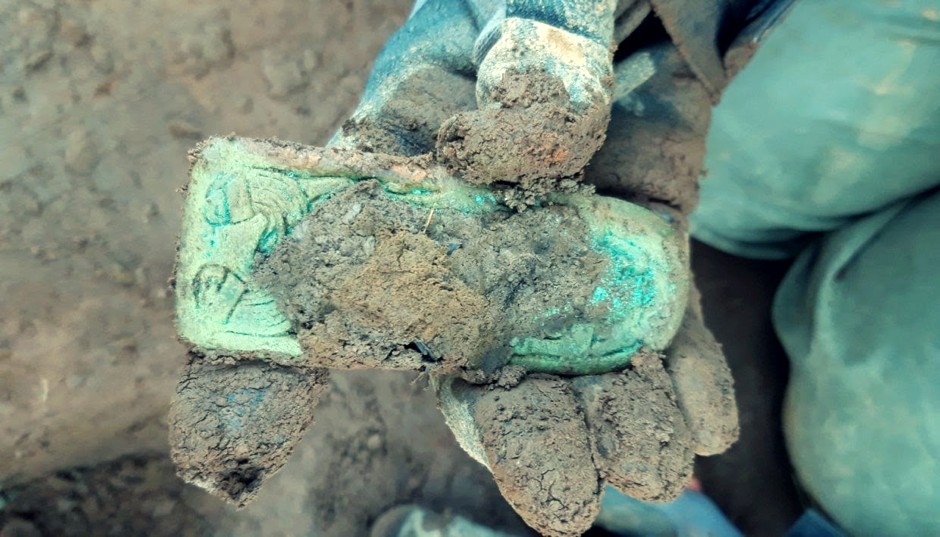
Here’s pattern A. It’s not twist-neutral by itself, but weaving the reverse will untwist that pattern! See pattern B…

Updated pattern B! If you were here on the first day, you will have noted there was an issue with the pattern–a few of the picks were missing at the end. I rebuilt the pattern and here it is!

And just for a little more variety, there were a couple other motif ideas that I saw, so I drafted those up as well.


I was thinking a bit tonight on period looms. We all want to go to a demo and use a period loom and wear our historic clothing and really look the part. Like we just stepped out of a medieval illustration.
In the SCA and in our modern lives, however, we often have to make concessions for budget, availability, accessibility, and ergonomics. I have usually done all my weaving on an inkle loom, which, to be frank, is a 19th century invention. However, I find it much more easy to work on, transport, maintain tension on my work, and most importantly, not hurt my back.

I have made a few other looms to weave on and have experimented with weaving on them with varying degrees of success.
The biggest one I made was this warp-weighted loom that I created using scraps from the garage. I based it on a number of drawings from books like Marta Hoffman’s “The Warp Weighted Loom” and several historic images.

Overall, it worked well, although I did decide that it could be a little bit shorter to better accommodate my height (or lack thereof). The weights were just bags of gravel, the yarn was wool, and the selvedge edge (across the top) was a woven piece with long wefts that became the warps of the project. I was able to weave a little bit on it, but it required standing and a fair amount of wall space. As this was a prototype and an experiment, I ended up packing it away and it’s living in the garage at the moment. I didn’t do any tablet weaving on it, however, and it seemed like much more tool than necessary for a narrow band. I have read about people doing the fabric weaving and using tablet weaving as part of the side selvedges, but this wasn’t included in my experiment.
Many people LOVE backstrap weaving, but I have tried it several times with NO success. It is ergonomically challenging and always ends in back pain for me. I did see this option of using two fixed points to weave, but this is also difficult to do in a place like a hotel lobby…
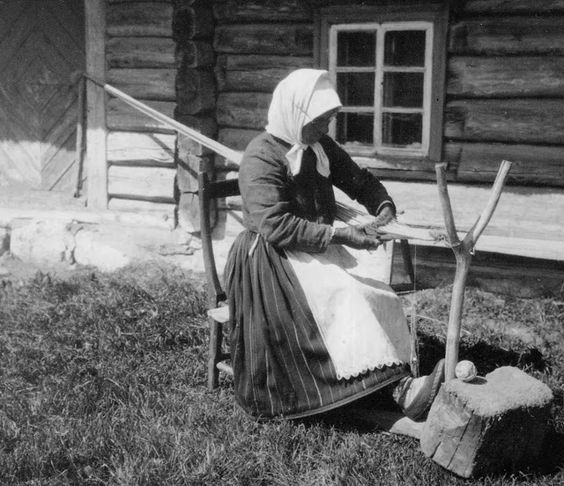
Looking to make something more portable, and easy to manufacture in bulk to teach a class, my friend and I made a bunch of “surfboard” looms. It was 1 x 4 lumber, a couple small blocks and some long screws and nuts (although this prototype has hex nuts, we swapped them out for wing nuts as they were easier to tighten by hand). It worked…mostly… There were some tension issues, but overall it was a workable loom for a class…but still not very period.
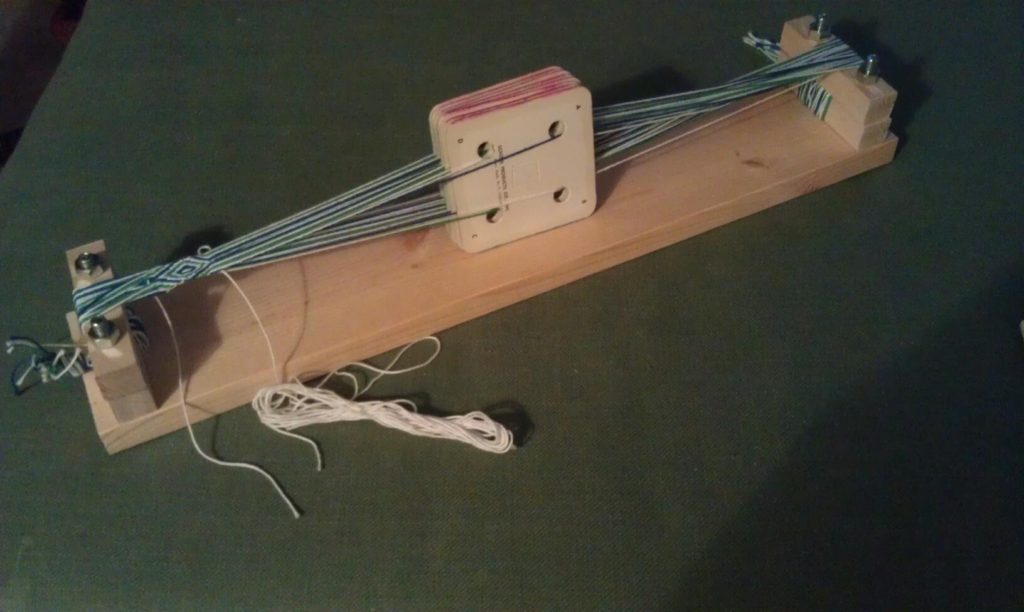
The next couple of experiments were rigid heddle and I didn’t do much with them as I was struggling with the tensioning systems…but then I tried making a 3D printed loom. Hubby has a printer and I thought it would be fun to try making it. After making several modifications from the original rigid heddle loom, I created this simple frame loom. In the end, very few parts were 3D printed–just the corner pieces and the ratchet and pawl assembly, which didn’t work quite as well as I needed–the pawl keeps popping out under tension. I did weave a couple pieces on it and it worked OK. It was a fun experiment, at least!
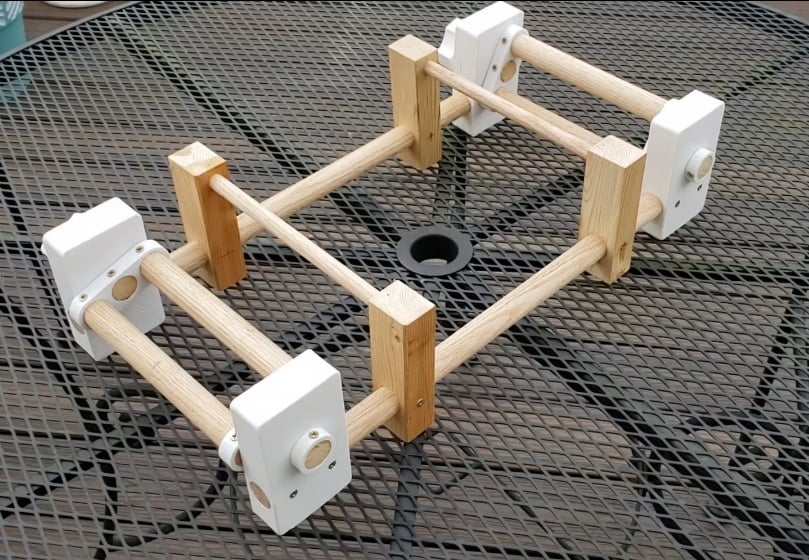
This is similar (at least in method) to the box looms of the later Middle Ages, like this image: La Noble Pastorale from c 1500. It is rather hard to see what’s going on here (blurry), but it’s clearly meant for narrow band weaving. It is more box-like, not a frame.
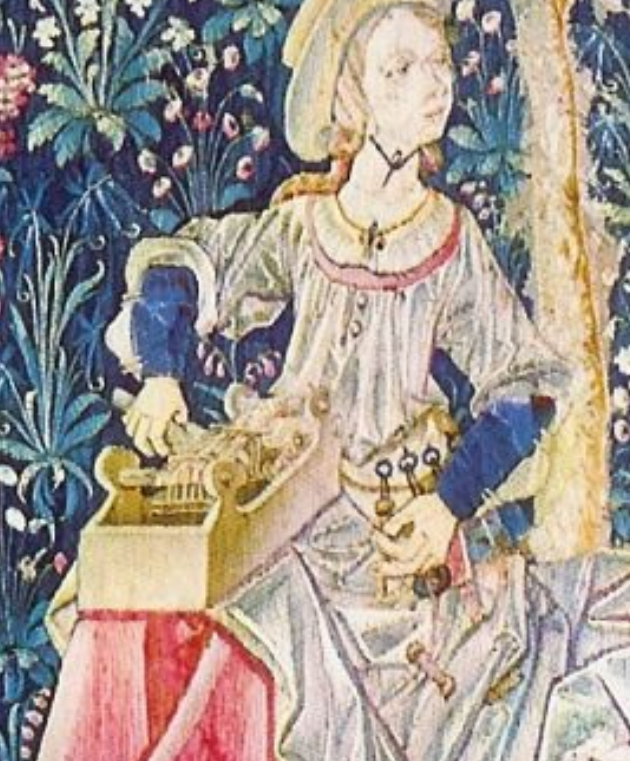
The next collection of looms are based on this pile of sticks–the Oseberg loom.

This remarkable find from the Oseberg farm in Norway dates to the 9th century which includes an unfinished piece of weaving with a whole bunch of cards. This is an upright loom that looks something like this:
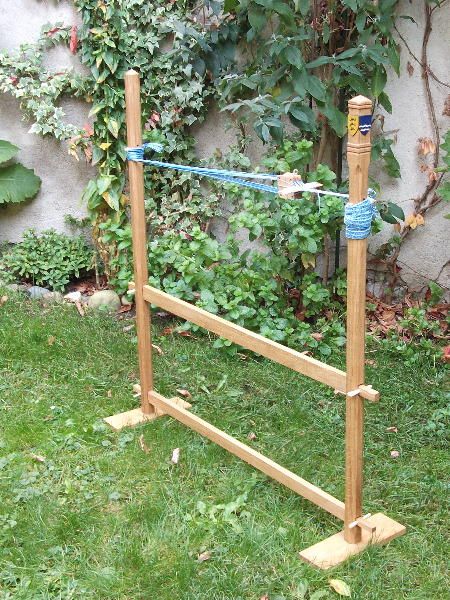
I love this modified loom design because it looks like it breaks down for easy transport! This is ideal for demo purposes and small vehicles.
Also, there are a number of medieval images of women using similar set ups for weaving, like this one:
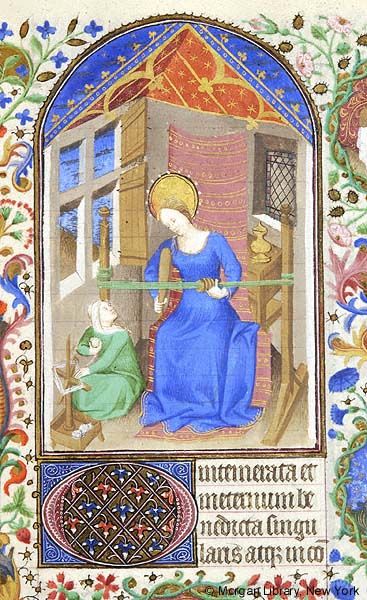
The plans for this loom were found on Pinterest, also.
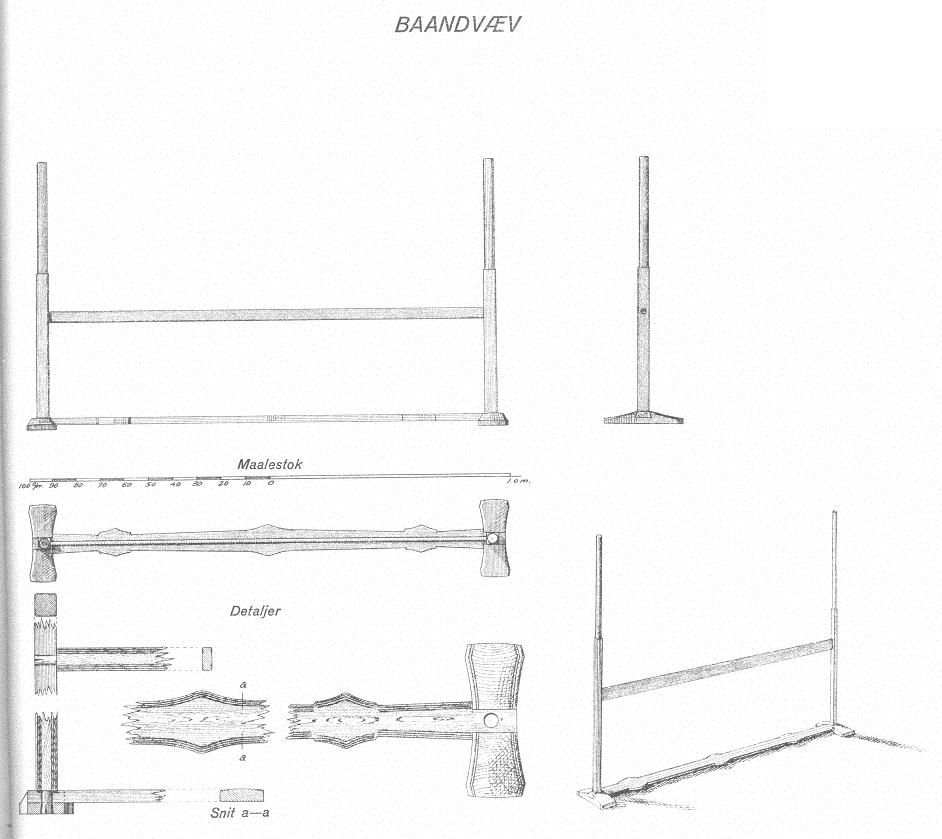
I took a class many years ago (in the 90s) from Master Fiacha, also a tablet weaver in An Tir, and he created these portable Oseberg-style table looms. It is a simple 2 x 4 and a couple dowels, and requires a clamp to hold it on the table, but it is a fairly usable tool.
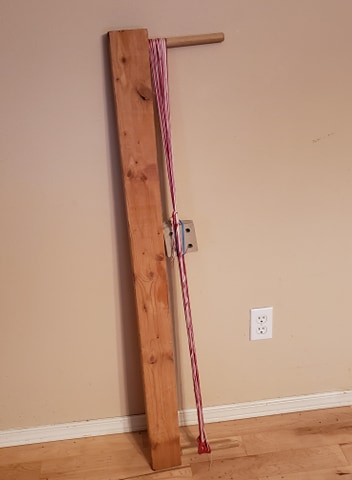
It was rather LONG, however, so I thought I’d try to create a more portable size using the original loom as inspiration.
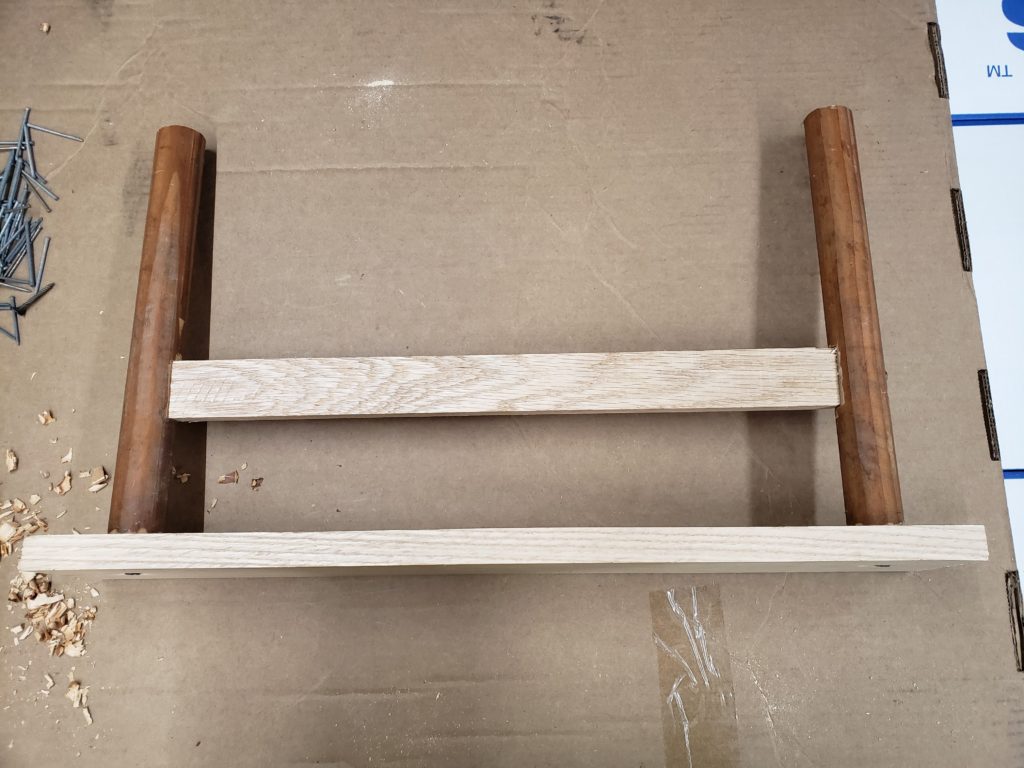
With just a couple of pieces of dimensional lumber, a couple of dowels, and 4 screws, this little loom went together quickly. It stands just over a foot tall and about 18″ long. It fits easily into a carry on bag, ready to fly off to exotic locales for vacation weaving!
I loaded up a project on it and worked it for a while, getting used to the angle and the wobbly nature of the cards as I worked. It was different, but not unmanageable.

So for future demos, I will be bringing the little Oseberg table loom with me to work on projects. It’s small and portable and fun to work on!
Elewys
I recently got a question about what tools and materials you need to get started weaving. I thought I had done a video (I did…sort of) or a blog post (a long time ago), so I figured it was time for an update. I have learned a lot in the last couple of years and found some new tricks and materials, so let’s start at the beginning.
This is one of those hobbies that doesn’t require a great deal of expensive tools and machinery to get started. There are few things that you need, and depending on your budget, you can make some economical choices or go hog wild and get All The Things!
The two things that you definitely need are cards and thread.

The cards can be purchased from most spinning and weaving stores, or you can find them on Amazon. I have an Amazon storefront that will give me a small commission for referrals–this is the link, which is also in the video description. There are a few different brands of cards to choose from. I have Schacht cards, which I quite like, but there are some cheaper options, also. There may also be some made from wood, although I find that many of the wood cards are a bit thick for my taste–the cardboard and 3D printed ones that are between .5mm and 1mm are the best size.
You can also get 3D printed cards from sellers on Etsy. Rowanberry Jam had some 3D printed cards you could buy, but appears to not be selling on Etsy at this time. I will keep looking for where Lidiya may have wandered off to…. In the meantime, there are some 3D printing patterns available on Thingiverse–so if you or someone you know has a 3D printer, you can print your own. I have quite a few and I love them!

You can also make the cards from cardstock–something like cereal box thickness. If you have a penchant for crafting, have the time and patience, or some fancy scrapbooking tools to help speed up the process, you may enjoy making your own. Round the corners of those homemade cards so they turn easier and avoid snagging on the threads as you weave. I have made some from granola bar boxes, from file folders, and gift boxes. Many people recommend making them from playing cards! Square them off, round the corners, and punch holes for the yarn.
Next you will need yarn. I have a preference for cotton–in the Medieval period, it was much more common to see wool, linen, and silk (and combinations of these), but I tend to use what is easily accessible and affordable. If you are just starting out, you may want to get some inexpensive stuff to start with.

Crochet cotton is some of the most accessible, inexpensive, and colorful options out there. Every craft store carries it; Michael’s carries Aunt Lydia’s Classic 10 which is perfect for this kind of weaving. It’s a #0 lace weight yarn, comes in 350-400 yard balls (varies by color), and comes in around 45 different colors. The ad I just looked at listed them at $3.69 per ball, so for under $10, you can get yarn enough for a few projects to help you decide if this craft is right for you. Choose 2 or 3 colors, using a variety of light and dark colors. Maybe choose the colors of your favorite sports team, your alma mater, your heraldry, or the heraldry of your favorite nation’s flag.


Another yarn option, which is a bit more expensive and more difficult to acquire, is either Maysville Carpet Warp, an 8/4 cotton; or Maurice Brassard 8/2 cotton. From the images, they look almost identical, but from this close-up of the yarn, side by side, you can see the Maysville is quite a bit thicker than the Maurice Brassard.

I have recently made the switch to the 8/2, and find that I prefer the lighter yarn for weaving. Those are generally not available at the local craft stores, but might be found at a specialty weaving store, or you can find them online at WEBS (www.yarn.com) or The Woolery (www.woolery.com).

If you really want to up your weaving game or looking for something very luxurious for a special occasion or gift, you can’t go wrong with SILK. Eowyn de Wever has been my go-to silk supplier, and she can be found at www.eowyndewever.com. The 60/2 is super fine…it’s like weaving with sewing thread, and unless you’re doing something with dozens of cards, this is probably not what you’re looking for. The 20/2 is more like a fine crochet cotton and is what I would recommend for most silk weaving. She has some available in cones or in 100 yard spools which is enough for a single project.
The only other thing you need is something to hold the work. There are looms, like the inkle looms I use (I own both a Beka loom and a Schacht loom, as well as an unmarked homemade loom that I bought second hand); a box loom; backstrap weaving, or warp weighted weaving. There are pros and cons to each of those, and you will have to do the research to determine what is right for you. I will cover those on the next blog post.
Stay cool, my friends…it’s a hot one out there! At least it has been here for the last week. 91 F (33 C). I know…it could be worse, but it’s just exhausting when you don’t have AC in the house. Definitely something we need to invest in.
Elewys
If you are new to tablet weaving and would like a very easy pattern to start with, this is a great one. It gives you the opportunity to work on your tension, your selvedge and beating between throws, and getting a nice overall finished product without getting lost in the turning sequences.

As always you will thread the cards labeled S from left to right, and Z from right to left.
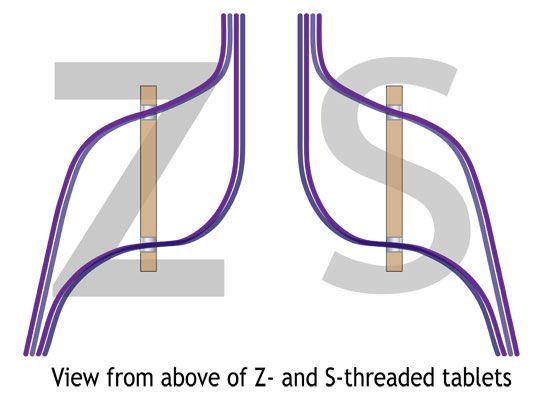
All cards will turn forward, throwing your shuttle after every quarter-turn, until the threads are over-twisted, and then you simply reverse direction until the threads become twisted in the opposite direction. It’s as easy as that!
The pattern I used for the Laurel Leaves pattern
I found this pattern years ago from Carolyn Priest-Dorman. She has a number of great articles and research on Norse-related topics here: https://www.cs.vassar.edu/~capriest/vikresource.html
I had wanted to try double face weaving again–it’s been years since I tried it–so I chose this pattern:
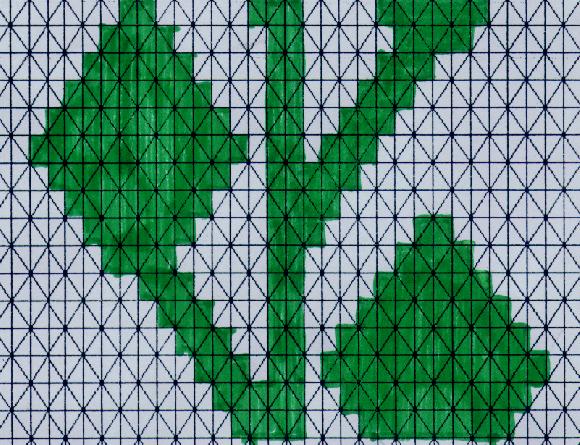
The pattern for this double face pattern can be found here: https://www.cs.vassar.edu/~capriest/laurel.html
But not being used to this kind of pattern and having reservations about trying to accurately follow this unusual draft, I decided to translate it into the TDD software and came up with this pattern:
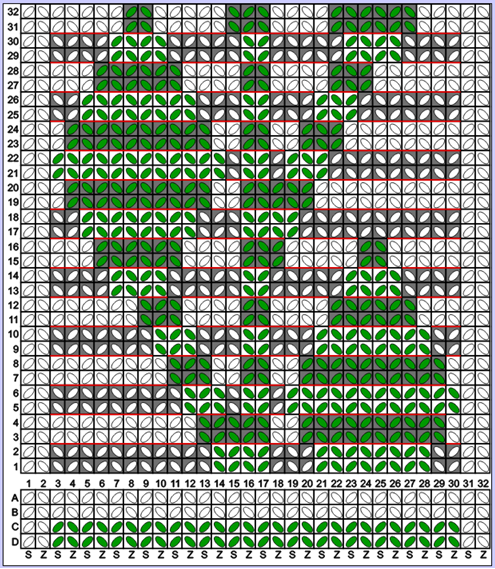
This should be pretty easy to follow, if you’re familiar with the TDD threading and turning notations.
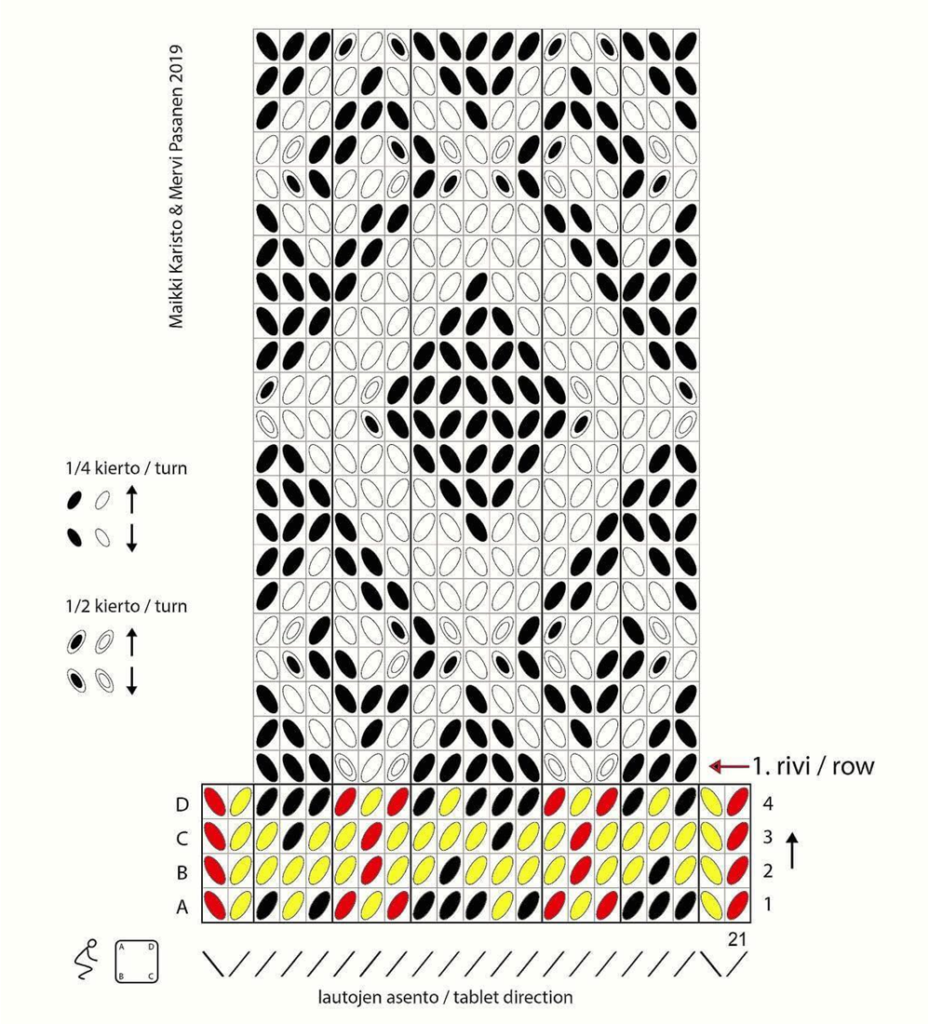
This is a lovely 11th century piece with some half-turns included, which are indicated by the ovals inside the ovals.
· Humikkala is a little town about 20 minutes northwest of Turku, Finland. Built around 1490-1510, the Masku Church and surroundings represents one of the oldest parishes in Western Finland. dedicated to John the Baptist and St. Ursula. Next to the church is the Masku Museum, founded in 1974, which has a collection of finds from the local area. Near the church, researchers found an Iron Age burial ground. The Humikkala cemetery, called the “hill of corpses” is on a hillside next to the Masku church. There were 49 inhumation graves found here, and this fragment came from grave 32. Like others, this find is dated to 1000-1100.
· A note about the identification of finds at these anthropological digs. While I couldn’t find the specific item number for THIS piece, I did find one for another one in the neighboring grave. This item was given the code KM 8656: H32:18 ; KM is Kansallismuseo = National Museum of Finland; the number 8656 identifies the dig site for the Humikkala findings, H means hauta = grave, 31 is the number of the grave, and 18 is the object number in that grave. Having these identifying numbers helps a great deal when you are looking for more information from the museums that store these finds. This piece was actually found in grave 32 (H32), so we know that the item code would start KM 8656: H32… I’m still looking for the item number on this guy…but having that much information narrows down the search tremendously.
Seija Sarkki researched it in the 1970´s publishing a book in 1979 called “Suomen ristiretkiaikaiset nauhat” or The Finnish Crusades.
Volume 18 of Helsingin Yliopiston arkeologian Laitos. Moniste
Moniste (Helsingin Yliopiston Arkeologian Laitos)
Volume 18 of Moniste / Helsingin yliopiston arkeologian laitos, ISSN 0355-1881 ISBN 9514516281, 9789514516283
Sarkki, S. (1979). Suomen Ristiretkiaikaiset Nauhat. Arkeologian Laitos. Helsinki, Helsingin Yliopisto.
Sarkki was not a weaver and had a unique way to translating the textiles by trying to figure out how they were woven, and Maikki Karisto, co author of Tablet-Woven Treasures and Applesies and Fox Noses, took her drawings and created patterns from them. This proved to be challenging for Maikki and Mervi Pasanen; the pattern above is the result of that reconstruction.
I hope you enjoy weaving this piece as much as I did! It’s got a lovely texture to it and will be a gorgeous addition to your medieval kit!
I’ve had a number of folks asking me about my loom, how it was made, where I bought it, etc. The answers are: it’s an Inkle loom–a 19th century invention (so…not medieval at all), unknown maker, and I bought it second hand more than 20 years ago. I think I bought it before I had kids…and my eldest is 23 now.
However, I am here to give you plans, dimensions, photos, and all the suggestions for improvement if I were to make it again. The discussion will be in the video, but this is where I wanted to post all the drawings (for what they’re worth–it’s been many a year since I took drafting, and I am not a proficient woodworker, so your mileage may vary).
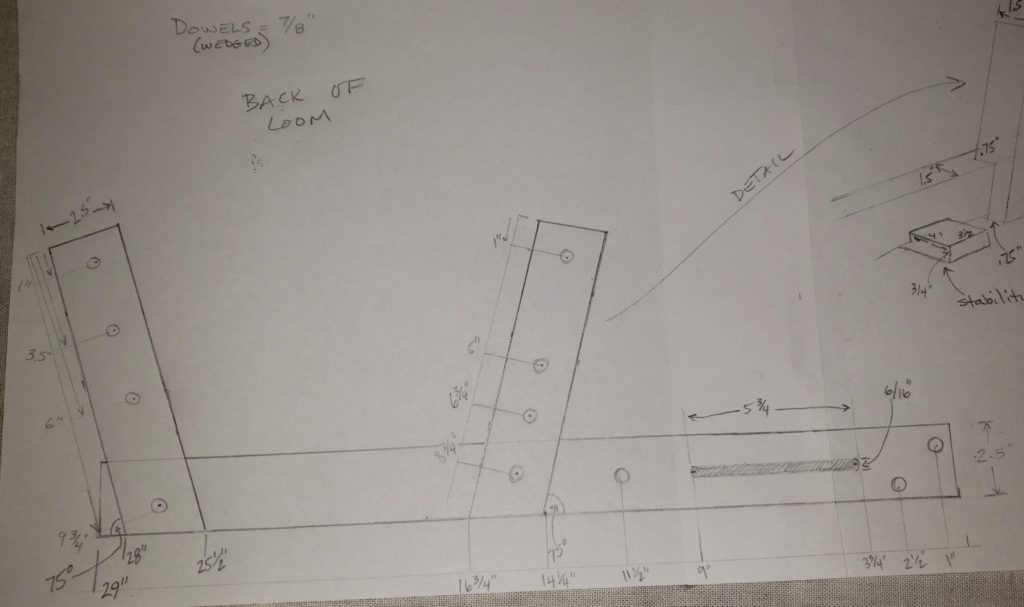
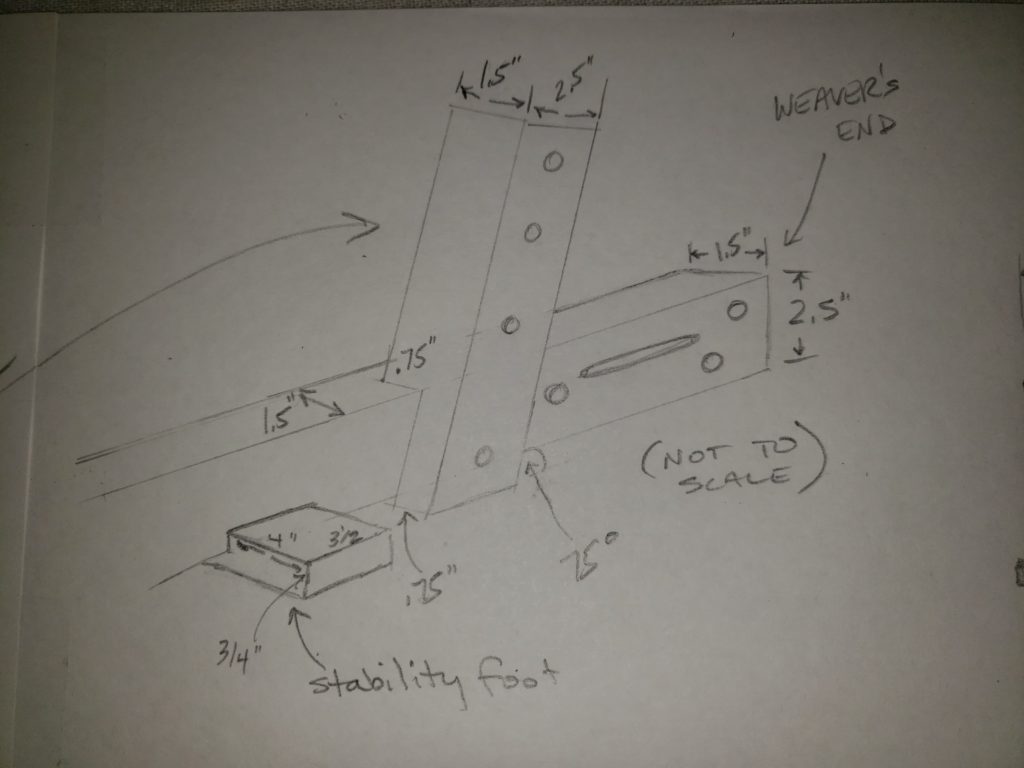
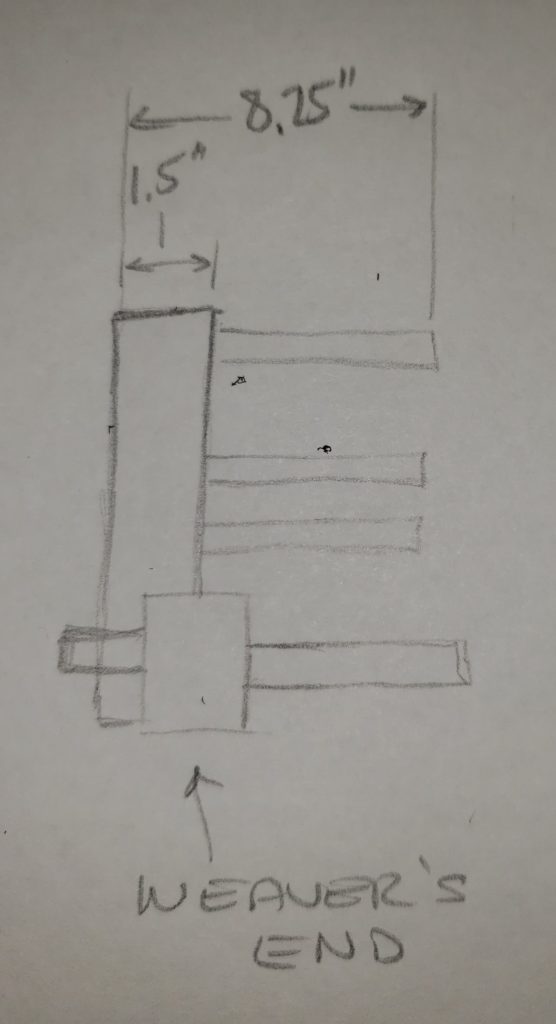
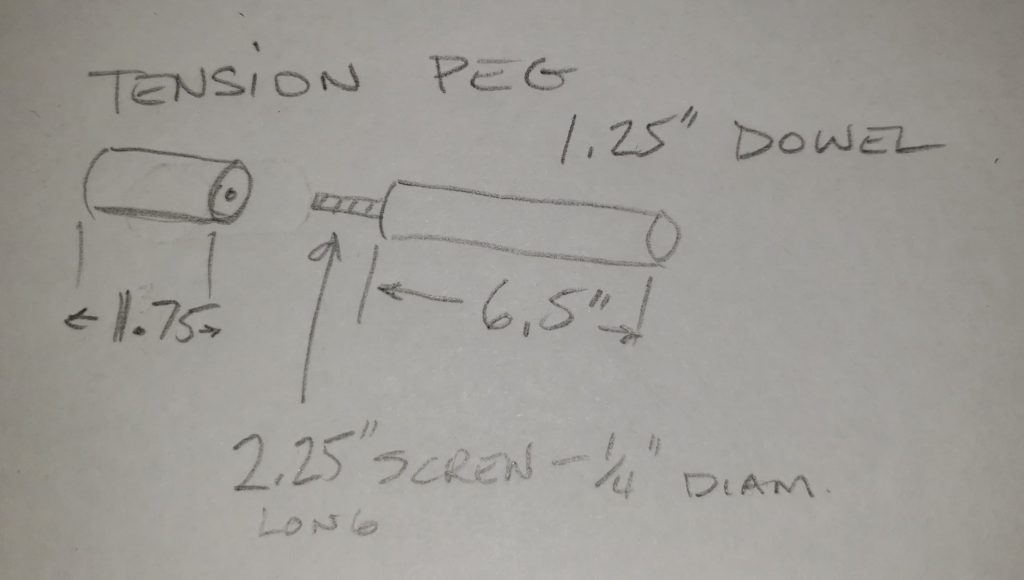
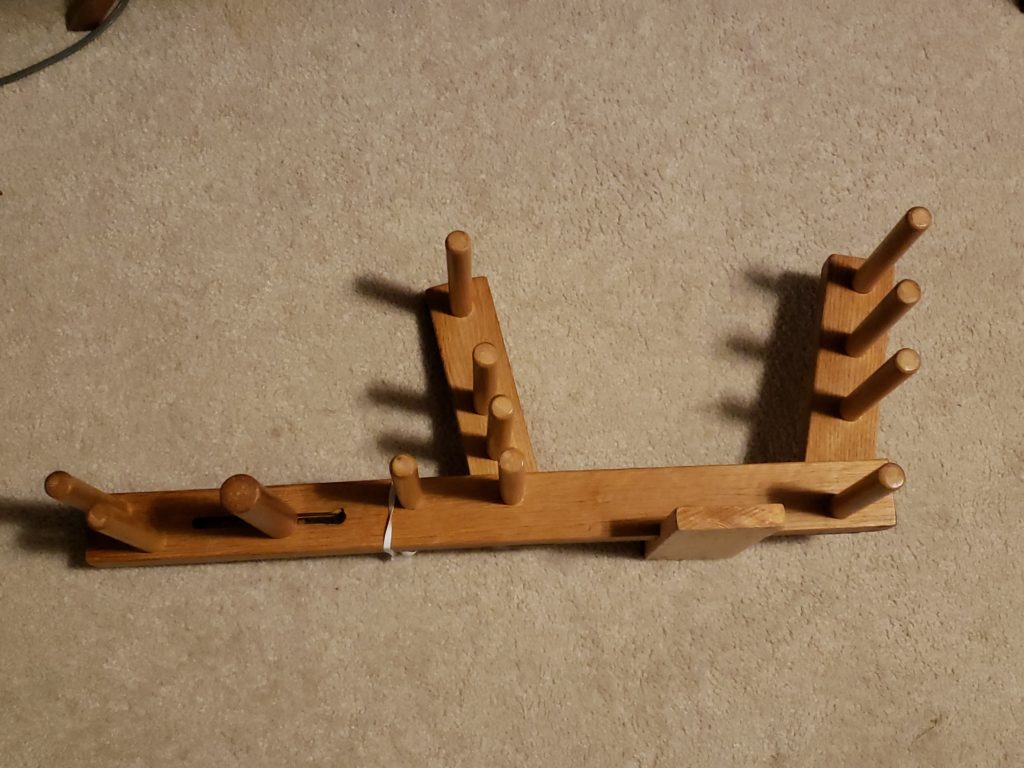

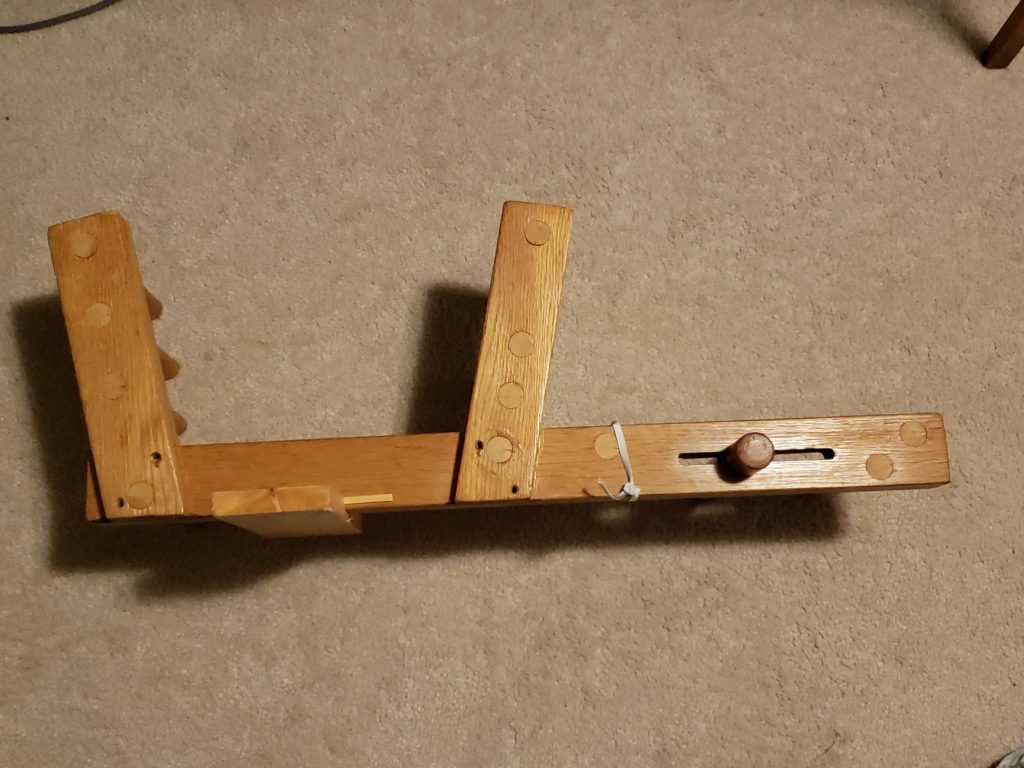



I hope you are able to translate these images and drawings into a loom of your own!
And when you find that this little guy isn’t enough for you…
